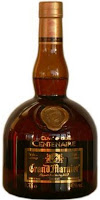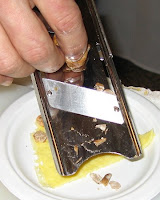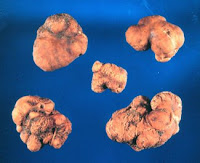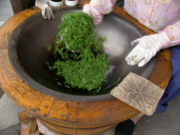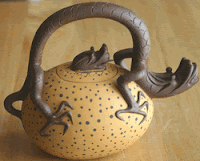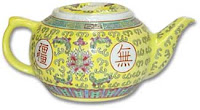 I'd like to take a look at a wine that is oft-overlooked. Madeira. This is a wine most misunderstood. Unfortunately, until recently, the American view of this type of wine has been a bit skewed by the cheaper versions, sometimes seasoned with salt or pepper and used for cooking. This is a wonderful wine that can be enjoyed as a dry aperitif or a sweet dessert wine. It is also a Protected Designation of Origin wine. As usual, I will explore the the wine, history, terroir and production in order to give you the comprehensive scoop.
I'd like to take a look at a wine that is oft-overlooked. Madeira. This is a wine most misunderstood. Unfortunately, until recently, the American view of this type of wine has been a bit skewed by the cheaper versions, sometimes seasoned with salt or pepper and used for cooking. This is a wonderful wine that can be enjoyed as a dry aperitif or a sweet dessert wine. It is also a Protected Designation of Origin wine. As usual, I will explore the the wine, history, terroir and production in order to give you the comprehensive scoop.Most would be surprised to learn that Madeira is one of the few wines on the market today that is 'cooked' to temperatures as high as 140°F for an extended period of time and is deliberately exposed to some levels of oxidation prior to being bottled. Its lifespan is quite long and even after you open a bottle, its shelf life can be a considerable amount of time. Exposure to extreme temperature and oxygen accounts for its stability; an opened bottle of Madeira will survive unharmed for up to a year. If left in the bottle unopened, Madeira is one of the longest lasting wines, known to survive over 150 years in excellent condition. Upon a 150 yr old bottle's opening, I imagine it would go something like, "Here, you try it." "Oh no no no, you try it first, I insist."
The islands of Madeira have a long wine-making history, when Madeira was a standard port of call for ships heading to the New World or East Indies. The Dutch East India Company became a regular customer, picking up large 112 gal casks of wine known as pipes for their voyages to India. To prevent the wine from spoiling, neutral grape spirits were added. On the long sea voyages, the wines would be exposed to excessive heat and movement which transformed the flavor of the wine, as the wine producers of Madeira found out, when an unsold shipment of wine returned to the islands after a round trip. The intense heat and constant movement of the ships had a transforming effect on the wine, and it was found that the customers preferred the taste of this style of wine and Madeira labeled as vinho da roda (wines that have made a round trip) became very popular.
Estufagem ...what makes Madeira so unique..
Immediately, producers found that aging the wine on long sea voyages was very costly and began to develop methods on the island to produce the same aged and heated style. They began storing the wines on trestles at the winery or in special rooms known as estufas where the heat of island sun would age the wine. The estufagem aging process duplicates the effect of a long sea voyage of the aging barrels through tropical climates. There are three main methods used to heat age the wine, according to the quality and cost of the finished wine.
 The most common, (Cuba de Calor) used for low cost Madeira, is bulk aging in low stainless steel or concrete tanks surrounded by either heat coils or piping that allows hot water to circulate around the container. The wine is heated to temperatures as high as 130 °F for a minimum of 90 days as regulated by the Madeira Wine Institute.
The most common, (Cuba de Calor) used for low cost Madeira, is bulk aging in low stainless steel or concrete tanks surrounded by either heat coils or piping that allows hot water to circulate around the container. The wine is heated to temperatures as high as 130 °F for a minimum of 90 days as regulated by the Madeira Wine Institute.The second method (Armazem de Calor) only used by the Madeira Wine Institute, involves storing the wine in large wooden casks in a
 specially designed room outfitted with steam producing tanks or pipes that heat the room, creating a type of sauna. This process more gently exposes the wine to heat and can last from six months to over a year.
specially designed room outfitted with steam producing tanks or pipes that heat the room, creating a type of sauna. This process more gently exposes the wine to heat and can last from six months to over a year. The third method (Canteiro) is used for the highest quality Madeiras aged without the use of any artificial heat, being stored by the winery in warm rooms left to age by the heat of the sun. In cases like vintage Madeira, this heating process can last from 20 years to 100 years. Much of the characteristic flavor of Madeira is due to this practice, which hastens the mellowing of the wine and also tends to check secondary fermentation in as much as it is, in effect, a mild kind of pasteurization.
The third method (Canteiro) is used for the highest quality Madeiras aged without the use of any artificial heat, being stored by the winery in warm rooms left to age by the heat of the sun. In cases like vintage Madeira, this heating process can last from 20 years to 100 years. Much of the characteristic flavor of Madeira is due to this practice, which hastens the mellowing of the wine and also tends to check secondary fermentation in as much as it is, in effect, a mild kind of pasteurization.Furthermore, the wine is
 deliberately exposed to air, causing it to oxidize, with the results giving the wine a color similar to a tawny port. Colorings such as caramel coloring have been used in the past to give some consistency although this practice is decreasing. Wine tasters sometimes describe an oxidized wine as being maderized.
deliberately exposed to air, causing it to oxidize, with the results giving the wine a color similar to a tawny port. Colorings such as caramel coloring have been used in the past to give some consistency although this practice is decreasing. Wine tasters sometimes describe an oxidized wine as being maderized. The initial wine-making steps of Madeira start out like most other wines with the grapes being harvested, crushed, pressed and then fermented in either stainless steel or oak cask. The grape varieties destined for sweeter wines, Boal and Malvasia, are often fermented with their skins to leach more phenols from the grapes to balance the sweetness of the wine. The more dry wines made from Sercial, Verdelho and Tinta Negra Mole are separated from their skins prior to fermentation. Depending on the level of sweetness desired, fermentation of the wine is halted at some point by the addition of neutral grape spirits, known as fortification. Producers of cheaper Madeira will usually ferment the wine completely dry, regardless of grape variety, and then fortify the wine so as not to lose any alcohol due to evaporation during the estufagem aging. The wines are then artificially sweetened and colored.
The initial wine-making steps of Madeira start out like most other wines with the grapes being harvested, crushed, pressed and then fermented in either stainless steel or oak cask. The grape varieties destined for sweeter wines, Boal and Malvasia, are often fermented with their skins to leach more phenols from the grapes to balance the sweetness of the wine. The more dry wines made from Sercial, Verdelho and Tinta Negra Mole are separated from their skins prior to fermentation. Depending on the level of sweetness desired, fermentation of the wine is halted at some point by the addition of neutral grape spirits, known as fortification. Producers of cheaper Madeira will usually ferment the wine completely dry, regardless of grape variety, and then fortify the wine so as not to lose any alcohol due to evaporation during the estufagem aging. The wines are then artificially sweetened and colored.The Grapes
- Sercial is nearly fermented completely dry with very little residual sugar (0.5 to 1.5° on the Baumé scale). This style of wine is characterized with high-toned colors, almond flavors and high acidity.
- Verdelho has its fermentation halted a little earlier than Sercial when its sugars are between 1.5 to 2.5
- Baumé This style of wine is characterized by smokey notes and high acidity. it has a dark color, medium rich texture with raisin flavors.
- Boal has its fermentation halted when its sugars are between 2.5 to 3.5°
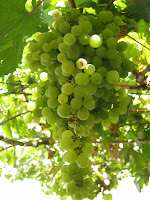 Malmsey (Malvasia) has its fermentation halted when its sugars are between 3.5 to 6.5° Baumé. This style of wine is characterized by its dark color, rich texture with coffee-caramel flavors. Like other Madeiras made from the noble grape varieties, the Malvasia grape used in Malmsey production has naturally high levels of acidity in the wine which balances with the high sugar levels so that the wines do not taste cloying sweet.
Malmsey (Malvasia) has its fermentation halted when its sugars are between 3.5 to 6.5° Baumé. This style of wine is characterized by its dark color, rich texture with coffee-caramel flavors. Like other Madeiras made from the noble grape varieties, the Malvasia grape used in Malmsey production has naturally high levels of acidity in the wine which balances with the high sugar levels so that the wines do not taste cloying sweet.
History
 |
| John Hancock |
Madeira was an important wine in the history of the United States of America. No wine quality grapes could be grown among the thirteen colonies so imports were needed with a great focus on Madeira. One of the major events on the road to revolution in which Madeira played a key role was the British seizure of John Hancock’s sloop the Liberty on May 9, 1768. Hancock's boat was seized after he had unloaded a cargo of 25 pipes (3,150 gallons) of Madeira and a dispute over import duties arose. The seizure of the Liberty caused riots to erupt among the people of Boston.
 |
| USS Constitution |
The Islands of Madeira
Madeira is a Portuguese archipelago that lies in the north Atlantic Ocean. It is one of the autonomous regions of Portugal, with Madeira Island and Porto Santo Island being the only inhabited islands. Madeira is part of the EU as an outermost region of the European Union. Madeira was discovered by Portuguese sailors some time between 1418 and 1420. The archipelago is considered to be the first discovery of the exploratory period initiated by Henry the Navigator of Portugal. It is a popular year-round resort, noted for its Madeira wine, flowers, and embroidery artisans, as well as its New Year's Eve celebrations that feature a spectacular fireworks show, which is the largest in the world according to the Guinness World Records. Its harbor, Funchal, is important due to its commercial and passenger traffic and for being a major stopover for cruisers en route from Europe to the Caribbean.
Madeira was discovered by Portuguese sailors some time between 1418 and 1420. The archipelago is considered to be the first discovery of the exploratory period initiated by Henry the Navigator of Portugal. It is a popular year-round resort, noted for its Madeira wine, flowers, and embroidery artisans, as well as its New Year's Eve celebrations that feature a spectacular fireworks show, which is the largest in the world according to the Guinness World Records. Its harbor, Funchal, is important due to its commercial and passenger traffic and for being a major stopover for cruisers en route from Europe to the Caribbean. Pliny( there he is again) mentions certain Purple Islands, the position of which with reference to the Fortunate Islands, or Canaries, may indicate Madeira islands. Plutarch (Sertorius, 75 AD) referring to the military commander Quintus Sertorius (d. 72 BC), relates that after his return to Cádiz, "he met seamen recently arrived from Atlantic islands, two in number, divided from one another only by a narrow channel and distant from the coast of Africa 10,000 furlongs. They are called Isles of the Blest." The estimated distance from Africa, and the closeness of the two islands, seem to indicate Madeira and Porto Santo.
Pliny( there he is again) mentions certain Purple Islands, the position of which with reference to the Fortunate Islands, or Canaries, may indicate Madeira islands. Plutarch (Sertorius, 75 AD) referring to the military commander Quintus Sertorius (d. 72 BC), relates that after his return to Cádiz, "he met seamen recently arrived from Atlantic islands, two in number, divided from one another only by a narrow channel and distant from the coast of Africa 10,000 furlongs. They are called Isles of the Blest." The estimated distance from Africa, and the closeness of the two islands, seem to indicate Madeira and Porto Santo.There is a romantic tale about two lovers, Robert Machim and Anna d'Arfet in time of the King Edward III of England, who, fleeing from England to France in 1346, were driven off their course by a violent storm, and cast onto the coast of Madeira at the place subsequently named Machico, in memory of one of them. On the evidence of a portolan dated 1351, preserved at Florence, Italy, it would appear that Madeira had
 been discovered long before that date by Portuguese vessels under Genoese captains.
been discovered long before that date by Portuguese vessels under Genoese captains.The three captain-majors had led, in the first trip, their respective families, a small group of people of the minor nobility, people of modest conditions and some old prisoners of the kingdom. To gain the minimum conditions for the development of agriculture, they had to rough-hew a part of the dense forest of laurisilva and to construct a large number of canals (levadas), since in some parts of the island, there was excess water, while in other parts water was scarce. In the earliest times, fish constituted about half of the settlers' diet, together with vegetables and fruit. The first local agricultural activity with some success was the raising of wheat. Initially, the colonists produced wheat for their own sustenance, but later began to export wheat to Portugal.
Geography and Climate
 Madeira island is 323.11 miles from the African coast and 621.37 miles from the European continent, which is the equivalent of a 1 hour 30 minute flight from Lisbon.
Madeira island is 323.11 miles from the African coast and 621.37 miles from the European continent, which is the equivalent of a 1 hour 30 minute flight from Lisbon.Madeira Island is the largest island of the group with an area of 286 sq mi, a length of 35 miles, a breadth of 14 miles at its widest point, and a coastline of (93.21 miles). Its longer axis lies east and west, along which lies a mountain chain with a mean altitude of 4,000 feet considered the backbone of the island from which many deep ravines radiate outward to the coast. Its most famous sea cliff, the Cabo Girão, is one of the highest in Europe. The highest point on the island is Pico Ruivo, at 6,107 ft.
A long, narrow, and comparatively low rocky promontory forms the eastern extremity of the island, on which lies a tract of calcareous sand known as the Fossil Bed. It contains land shells and numerous bodies resembling the roots of trees, probably produced by infiltration.
Madeira Island's geographical position and mountainous landscape result in a very pleasant climate which varies between the north side, south side, and smaller islands groups like Porto Santo and Savages. The mean annual temperature on the coastline can reach more than 20 °C (68 °F) in the south. With its mild humidity, the weather of the island is classified as oceanic subtropical and with its low rain level, desertic on the Savages. Influenced by the Gulf Stream, sea water temperature varies between 79 °F during the summer and 63 °F in the winter.
My Recommended Madiera
 Brought to you by Broadbent Selections which offers many many varieties of wine from all over the world. Michael & Bartholomew are two of the world's foremost experts in Port & Madeira, so these selections were a no brainier. When speaking with Bartholomew, he pointed out that they have paid very close attention to price-point, with most of their selections available at less than $50.00US. All can be purchased from Broadbent's website (see link above).
Brought to you by Broadbent Selections which offers many many varieties of wine from all over the world. Michael & Bartholomew are two of the world's foremost experts in Port & Madeira, so these selections were a no brainier. When speaking with Bartholomew, he pointed out that they have paid very close attention to price-point, with most of their selections available at less than $50.00US. All can be purchased from Broadbent's website (see link above). Broadbent Rainwater (Medium Dry) $16.95
Aged in oak casks for at least 3 years. Esteemed for its concentrated aroma and subtle flavor, it can be served as an apéritif or as an after dinner drink. Clear dark reddish-copper in color, it breathes classic and very appealing Madeira scents of dried dates and figs and mixed nuts. Smooth and gently sweet, it's not a "sticky" dessert wine but shows good fresh-fruit sweetness built on Madeira's sturdy core of tart, lemony acidity. Specifics
 Broadbent 10 Year Old Malmsey (Sweet) $48.95
Broadbent 10 Year Old Malmsey (Sweet) $48.95Aged in oak casks for at least 10 years. A superb, full-bodied, wonderfully rich Madeira with a sweet, rich chocolaty flavor and a concentrated bouquet. Best enjoyed with desserts, or on its own after a meal. Specifics.
Well there you have it. I hope you enjoyed this article as much as I did writing it. As always, we encourage you to please drink responsibly.
Bon Appetit!
Lou
Sources: media-cdn.tripadvisor.com, destination360.com, wikipedia.org, Broadbent Selections, www.visitportugal.com














